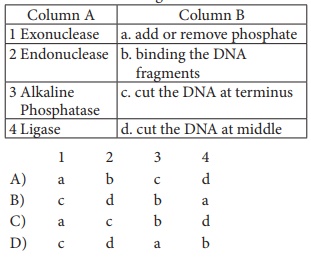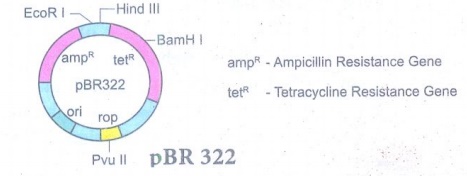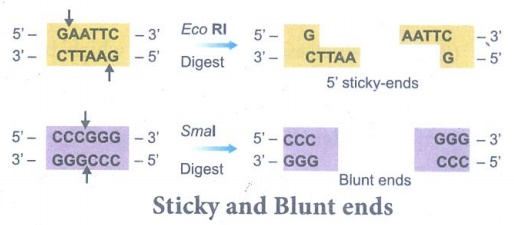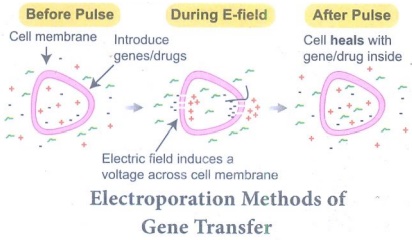Important Questions and choose the correct answer - Important Questions and choose the correct answerBotany - Principles and Processes of Biotechnology: Evaluation | 12th Botany : Chapter 4 : Principles and Processes of Biotechnology
Chapter: 12th Botany : Chapter 4 : Principles and Processes of Biotechnology
Principles and Processes of Biotechnology: Evaluation
Botany : Principles and Processes of Biotechnology
Evaluation
Choose the Correct Answers
1. Restriction enzymes are
a. Not always required in genetic engineering
b. Essential tools in genetic engineering
c. Nucleases that cleave DNA at specific sites
d. both b and c
2. Plasmids are
a. circular protein molecules
b. required by bacteria
c. tiny bacteria
d. confer resistance to antibiotics
3. EcoRI cleaves DNA at
a. AGGGTT
b. GTATATC
c. GAATTC
d. TATAGC
4. Genetic engineering is
a. making artificial genes.
b. hybridization of DNA of one organism to that of the others.
c. production of alcohol by using micro organisms.
d. making artificial limbs, diagnostic instruments such as ECG, EEG etc.,
5. Consider the following statements:
I. Recombinant DNA technology is popularly known as genetic engineering is a stream of biotechnology which deals with the manipulation of genetic materials by man invitro
II. pBR322 is the first artificial cloning vector developed in 1977 by Boliver and Rodriguez from E.coli plasmid
III. Restriction enzymes belongs to a class of enzymes called nucleases.
Choose the correct option regarding above statements
a. I & II
b. I & III
c. II & III
d. I,II & III
6. The process of recombinant DNA technology has the following steps
I. amplication of the gene
II. Insertion of recombinant DNA into the host cells
III. Cutting of DNA at specific location using restriction enzyme .
IV. Isolation of genetic material (DNA) Pick out the correct sequence of step for recombinant DNA technology.
a. II, III, IV, I
b. IV, II, III, I
c. I, II, III, IV
d. IV, III, I, II
7. Which one of the following palindromic base sequence in DNA can be easily cut at about the middle by some particular restriction enzymes?
a. 5’ CGTTCG 3’ 3’ ATCGTA 5’
b. 5’ GATATG 3’ 3’ CTACTA 5’
c. 5’ GAATTC 3’ 3’ CTTAAG 5’
d. 5’ CACGTA 3’ 3’ CTCAGT 5’
8. pBR 322, BR stands for
a. Plasmid Bacterial Recombination
b. Plasmid Bacterial Replication
c. Plasmid Boliver and Rodriguez
d. Plasmid Baltimore and Rodriguez
9. Which of the following one is used as a Biosensors?
a. Electrophoresis
b. Bioreactors
c. Vectors
d. Electroporation
10. Match the following :

Answer: d
11 In which techniques Ethidium Bromide is used?
a. Southern Blotting techniques
b. Western Blotting techniques
c. Polymerase Chain Reaction
d. Agrose Gel Electroporosis
12 Assertion : Agrobacterium tumifaciens is popular in genetic engineering because this bacteriumis associated with the root nodules of all cereals and pulse crops
Reason: A gene incorporated in the bacterial chromosomal genome gets atomatically transferred to the cross with which bacterium is associated.
a) Both assertion and reason are true. But reason is correct explanation of assertion.
b) Both assertion and reason are true. But reason is not correct explanation of assertion.
c) Assertion is true, but reason is false. d) Assertion is false, but reason is true.
e) Both assertion and reason are false.
13 Which one of the following is not correct statement.
a) Ti plasmid causes the bunchy top disease
b) Multiple cloning site is known as Polylinker
c) Non viral method transfection of Nucleic acid in cell
d) Polylactic acid is a kind of biodegradable and bioactive thermoplastic.
14 An analysis of chromosomal DNA using the southern hybridisation technique does not use
a) Electrophoresis
b) Blotting
c) Autoradiography
d) Polymerase Chain Reaction
15 An antibiotic gene in a vector usually helps in the selection of
a) Competent cells
b) Transformed cells
c) Recombinant cells
d) None of the above
16 Some of the characteristics of Bt cotton are
a) Long fibre and resistant to aphids
b) Medium yield, long fibre and resistant to beetle pests
c) high yield and production of toxic protein crystals which kill dipteran pests.
d) High yield and resistant to ball worms
Answer the following questions
17. How do you use the biotechnology in modern practice?
Answer: Modern biotechnology embraces all methods of genetic modification by recombinant DNA and cell fusion technology. The major focus of biotechnology are:
(i) Fermentation for production of acids, enzymes, alcohols, antibiotics, fine chemicals, vitamins and toxins.
(ii) Biomass for bulk production of single cell protein , alcohol, and biofuel.
(iii) Enzymes as biosensors, in processing industry.
(iv) Biofuels for production of hydrogen, alcohol, methane.
(v) Microbial inoculants as biofertiliser, and nitrogen fixers
(vi) Plant and animal cell culture for production of secondary metabolites, monoclonal antibodies.
(vii) Recombinant DNA technology for production of fine chemicals, enzymes, vaccines, growth hormones, antibiotics, and interferon.
(viii) Process engineering - tools of biotechnology is used for effluent treatment, water recycling.
18. What are the materials used to grow microorganism like Spirulina?
Answer: (i) Spirulina can be grown easily on materials like waste water from potato processing plants (containing starch), straw, molasses, animal manure and even sewage, to produce large quantities and can serve as food rich in protein, minerals, fats, carbohydrate and vitamins.
(ii) Such utilization also reduces environmental pollution.
(iii) 250 g of Methylophilus methylotrophus, as its high rate of biomass production and growth, can be expected to produce 25 tonnes of protein.
19. You are working in a biotechnology lab with a becterium namely E.coli. How will you cut the nucleotide sequence? explain it.
Answer: (i) A restriction enzyme or restriction endonuclease is an enzyme that cleaves DNA into fragments at or near specific recognition sites within the molecule known as restriction sites.
(ii) Based on their mode of action restriction enzymes are classified into Exonucleases and Endonucleases.
(a) Exonucleases are enzymes which removenucleotides one at a time from the end of a DNA molecule.
(b) Endonucleases are enzymes which break the internal phosphodiester bonds within a DNA molecule.
There are three main classes of restriction endonuclease:
Type I, Type II and Type III
They differ slightly by their mode of action.
Based on the position at which we wish to cut the nucleotide sequence and type of cleavage the corresponding restriction endonuclease may be used.
20. What are the enzymes you can used to cut terminal end and internal phospho di ester bond of nucleotide sequence?
Answer: A restriction enzyme or restriction endonuclease is an enzyme that cleaves DNA into fragments at or near specific recognition sites within the molecule known as restriction sites.
(i) Exonucleases are enzymes which remove nucleotides one at a time from the end of a DNA molecule.
Example: Bal 31, Exonuclease III.
(ii) Endonucleases are enzymes which break the internal phosphodiester bonds within a DNA molecule.
Example: Hind II, EcoRI, TaqI.
21. Name the chemicals used in gene transfer.
Answer: Chemical mediated gene transfer: Certain chemicals like polyethylene glycol (PEG) and dextran sulphate induce DNA uptake into plant protoplasts.
22. What do you know about the word pBR332?
Answer: pBR 322 Plasmid:
(i) pBR 322 plasmid is a reconstructed plasmid and most widely used as cloning vector; it contains 4361 base pairs.
(ii) In pBR, p denotes plasmid, B and R respectively the names of scientist B Oliver and Rodriguez who developed this plasmid. The number 322 is the number of plasmid developed from their laboratory.
(iii) It contains ampR and tetR two different antibiotic resistance genes and recognition sites for several restriction enzymes. (Hind III, EcoRI, BamH I, Sal I, Pvu II, Pst I, Cla I), ori and antibiotic resistance genes.

ampR - Ampicillin Resistance Gene
tetR - Tetracycline Resistance Gene
pBR 322
(iv) Rop codes for the proteins involved in the replication of the plasmid.
23. Mention the application of Biotechnology.
Answer: (i) Biotechnology is one of the most important applied interdisciplinary sciences of the 21st century. It is the trusted area that enables us to find the beneficial way of life.
(ii) Biotechnology has wide applications in various sectors like agriculture, medicine, environment and commercial industries.
(iii) This science has an invaluable outcome like transgenic varieties of plants e.g. transgenic cotton (Bt-cotton), rice, tomato, tobacco, cauliflower, potato and banana.
(iv) The development of transgenics as pesticide resistant, stress resistant and disease resistant varieties of agricultural crops is the immense outcome of biotechnology.
(v) The synthesis of human insulin and blood protein in E.coli and utilized for insulin deficiency disorder in human is a breakthrough in biotech industries in medicine.
(vi) The synthesis of vaccines, enzymes, antibiotics, dairy products and beverages are the products of biotech industries.
(vii) Biochip based biological computer is one of the successes of bio technology.
(viii) Genetic engineering involves genetic manipulation, tissue culture involves aseptic cultivation of totipotent plant cell into plant clones under controlled atmospheric conditions.
(ix) Single cell protein from Spirulina is utilized in food industries.
(x) Production of secondary metabolites, biofertilizers, biopesticides and enzymes.
(xi) Biomass energy, biofuel, bioremediation, phytoremediation for environmental biotechnology.
24. What are restriction enzyme. Mention their type with role in Biotechnology.
Answer: Restriction Enzymes:
(i) A restriction enzyme or restriction endonuclease is an enzyme that cleaves DNA into fragments at or near specific recognition sites within the molecule known as restriction sites.
(ii) Based on their mode of action restriction enzymes are classified into Exonucleases and Endonucleases.
(a) Exonucleases are enzymes which remove nucleotides one at a time from the end of a DNA molecule.
Example: Bal 31, Exonuclease III.
(b) Endonucleases are enzymes which break the internal phosphodiester bonds within a DNA molecule.
Example: Hind II, EcoRI, TaqI.
Restriction endonuclease: Molecular scissors:
(i) The restriction enzymes are called as molecular scissors. These act as foundation of recombinant DNA technology.
(ii) There are three main classes of restriction endonuclease : Type I, Type II and Type III, which differ slightly by their mode of action.
(iii) Only type II enzyme is preferred for use in recombinant DNA technology as they recognise and cut DNA within a specific sequence typically consisting of 4-8 bp. Example: EcoRI.
(iv) The restriction enzyme Hind II always cut DNA molecules at a point of recognising a specific sequence of six base pairs. This sequence is known s recognition sequence. Today more than 900 restriction enzymes that have been isolated from over 230 strains of bacteria with different recognition sequences.
(v) Restriction endonucleases are named by a standard procedure.
(vi) For example, EcoRI is from Escherichia (E) coli (co), strain RY 13 (R) and first endonuclease (I) to be discovered.
(vii) It contains 2 different antibiotic resistance genes and recognition site for several restriction enzymes. This sequence is referred to as a restriction site and is generally -palindromic which means that the sequence in both DNA strands at this site read same in 5’ - 3’ direction and in the 3’-5’ direction.
(viii) The exact kind of cleavage produced by a restriction enzyme is important in the design of a gene cloning experiment.
(ix) Some cleave both strands of DNA through the centre resulting in blunt or flush end. These are known as symmetric cuts.
(x) Some enzymes cut in a way producing protruding and recessed ends known as sticky or cohesive end. Such cut are called staggered or asymmetric cuts.

Sticky and Blunt ends
25. Is their any possibilities to transfer a suitable desirable gene to host plant without vector? Justify your answer.
Answer: Direct or Vectorless Gene Transfer:
In the direct gene transfer methods, the foreign gene of interest is delivered into the host plant without the help of a vector. The following are some of the common methods of direct gene transfer in plants.
a. Chemical mediated gene transfer: Certain chemicals like polyethylene glycol (PEG) and dextran sulphate induce DNA uptake into plant protoplasts.
b. Microinjection: The DNA is directly injected into the nucleus using fine tipped glass needle or micro pipette to transform plant cells. The protoplasts are immobilised on a solid support (agarose on a microscopic slide) or held with a holding pipette under suction.
c. Electroporation: Methods of Gene Transfer: A pulse of high voltage is applied to protoplasts, cells or tissues which makes transient pores in the plasma membrane through which uptake of foreign DNA occurs.
d. Liposome mediated method of gene transfer: Liposomes the artificial phospholipid vesicles are useful in gene transfer. The gene or DNA is transferred from liposome into vacuole of plant cells. It is carried out by encapsulated DNA into the vacuole. This technique is advantageous because the liposome protects the introduced DNA from being damaged by the acidic pH and protease enzymes present in the vacuole. Liposome and tonoplast of vacuole fusion resulted in gene transfer. This process is called lipofection.

e. Biolistics: The foreign DNA is coated onto the surface of minute gold or tungsten particles (1-3 µm) and bombarded onto the target tissue or cells using a particle gun (also called as gene gun/micro projectile gun/shotgun). Then the bombarded cells or tissues are cultured on selected medium to regenerate plants from the transformed cells.
26. How will you identify a vectors?
Answer: (i) Major component of a gene cloning experiment is a vector such as a plasmid.
(ii) A Vector is a small DNA molecule capable of self-replication and is used as a carrier and transporter of DNA fragment which is inserted into it for cloning experiments.
(iii) Vector is also called cloning vehicle or cloning DNA. Vectors are of two types:
(a) Cloning Vector, and
(b) Expression Vector.
Cloning vector is used for the cloning of DNA insert inside the suitable host cell. Expression vector is used to express the DNA insert for producing specific protein inside the host.
Properties of Vectors:
Vectors are able to replicate autonomously to produce multiple copies of them along with their DNA insert in the host cell.
(i) It should be small in size and of low molecular weight, less than 10 Kb (kilo base pair) in size so that entry/transfer into host cell is easy.
(ii) Vector must contain an origin of replication so that it can independetly replicate within the host.
(iii) It should contain a suitable marker such as antibiotic resistance, to permit its detection in transformed host cell.
(iv) Vector should have unique target sites for integration with DNA insert and should have the ability to integrate with DNA insert it carries into the genome of the hostcell. Most of the commonly used cloning vectors have more than one restriction site. These are Multiple Cloning Site (MCS) or polylinker. Presence of MCS facilitates the use of restriction enzyme of choice.
The following are the features that are required to facilitate cloning into a vector.
1. Origin of replication (ori): This is a sequence from where replication starts and piece of DNA when linked to this sequence can be made to replicate within the host cells.
2. Selectable marker: In addition to ori the vector requires a selectable marker, which helps in identifying and eliminating non transformants and selectively permitting the growth of the transformants.
3. Cloning sites: In order to link the alien DNA, the vector needs to have very few, preferably single, recognition sites for the commonly used restriction enzymes.
27. Compare the various types of Blotting techniques.
Answer: Southern Blotting : The transfer of DNA from agarose gels to nitrocellulose membrane.
Northern Blotting: The transfer of RNA to nitrocellulose membrane.
Western Blotting : Electrophoretic transfer of Proteins to nitrocellulose membrane.

28. Write the advantages of herbicide tolerant crops.
Answer: Advantages of Herbicide Tolerant Crops:
(i) Weed control improves higher crop yields.
(ii) Reduces spray of herbicide.
(iii) Reduces competition between crop plant and weed.
(a) Use of low toxicity compounds which do not remain active in the soil.
(iv) The ability to conserve soil structure and microbes.
29. Write the advantages and disadvantages of Bt cotton.
Answer: Advantages of Bt cotton:
(i) Yield of cotton is increased due to effective control of bollworms.
(ii) Reduction in insecticide use in the cultivation of Bt cotton.
(iii) Potential reduction in the cost of cultivation.
Disadvantages of Bt cotton:
(i) Cost of Bt cotton seed is high.
(ii) Effectiveness up to 120 days after that efficiency is reduced.
(iii) Ineffective against sucking pests like jassids,aphids and whitefly.
(iv) Affects pollinating insects and thus yield.
30. What is bioremediation? give some examples of bioremediation.
Answer: Bioremediation:
It is defined as the use of microorganisms or plants to clean up environmental pollution. It is an approach used to treat wastes including wastewater, industrial waste and solid waste. Bioremediation process is applied to the removal of oil, petrochemical residues, pesticides or heavy metals from soil or ground water. In many cases, bioremediation is less expensive and more sustainable than other physical and chemical methods of remediation. Bioremediation process is a cheaper and eco-friendly approach and can deal with lower concentrations of contaminants more effectively. The strategies for bioremediation in soil and water can be as follows:
(i) Use of indigenous microbial population as indicator species for bioremediation process.
(ii) Bioremediation with the addition of adapted or designed microbial inoculants.
(iii) Use of plants for bioremediation - green technology.
Some examples of bioremediation technologies are:
(i) Phytoremediation - use of plants to bring about remediation of environmental pollutants.
(ii) Mycoremediation - use of fungi to bring about remediation of environmental pollutants.
(iii) Bioventing is the process that increases the oxygen or air flow to accelerate the degradation of environmental pollutants.
(iv) Bioleaching is the use of microorganisms in solution to recover metal pollutants from contaminated sites.
31. Write the benefits and risk of Genetically Modified Foods.
Answer: GM Food - Benefits:
(i) High yield without pest.
(ii) 70% reduction of pesticide usage.
(iii) Reduce soil pollution problem.
(iv) Conserve microbial population in soil.
Risks - believed to
(i) Affect liver, kidney function and cancer.
(ii) Hormonal imbalance and physical disorder.
(iii) Anaphylactic shock (sudden hypersensitive reaction) and allergies.
(iv) Adverse effect in immune system because of bacterial protein.
(v) Loss of viability of seeds show in terminatorseed technology of GM crops.
Glossary
3’ Hydroxy end: The hydroxyl group attached to 3’ carbon atom of sugar of the terminal nucleotide of a nucleic acid.
Bacterial artificial chromosomes (BAC): A cloning vector for isolation of genomic DNA constructed on the basis of F-factor.
Chimeric DNA: A recombinant DNA molecule containing unrelated genes.
Cleave: To break phosphodiester bonds of dsDNA, usually with a restriction enzyme.
Cloning site: A location on a cloning vector into which DNA can be inserted.
Cloning: Incorporation of a DNA molecule into a chromosomal site or a cloning vector.
Cloning Vector: A small, self-replicating DNA inserted in a cloning gene.
COS sites: The 12-base, single strand, complementary extension of phage lambda (l) DNA.
DNA Polymerase: An enzyme that catalyses the phosphodiester bond in the formation of DNA.
Endonucleases: An enzyme that catalyses the cleavage of DNA at internal position, cutting DNA at specific sites.
Genome: The entire complement of genetic material of an organism.
Insert DNA: A DNA molecule incorporated into a cloning vector.
Ligase: An enzyme used in genetic engineering experiment to join the cut ends of dsDNA.
M-13: AssDNA bacteriophage used as vector for DNA sequencing.
Phagemid: A cloning vector that contains components derived from both phage DNA and plasmid.
Plasmid: Extrachromosomal, self-replicating, circular dsDNA containing some non-essential genes.
Restriction map: A linear array of sites on DNA cleaved by various restriction enzymes.
Shuttle Vector: A plasmid cloning vector that can replicate in two different organisms due to the presence of two different origin of replication OriEUK and OriE. coli
Taq polymerase: A heat stable DNA polymerase isolated from a thermophilic bacterium Thermus aquaticus.
Vectors: Vehicles for transferring DNA from one cell to another.
Biofuel: Fuels like hydrogen, ethanol and methanol produced from a biological source by the action of microorganisms.
Bioleaching: Process of using microorganisms to recover metals from their ores or contaminant environment
Bioremediation: Process of using organisms to remove or reduce pollutants from the environment.
Green Technology: Pollution-free technology in which pollution is controlled at source.
Phytoremediation: Use of certain plants to remove contaminants or pollutants from the environment (soil, water or air).
Recombinant: Cell / Organism formed by a recombination of genes.
Transformation: Process of transferring a foreign DNA into a cell and changing its genome.
Vector: Agent used in recombinant DNA technique to carry new genes into foreign cells.
Wild Type: Natural form of organisms.
Related Topics